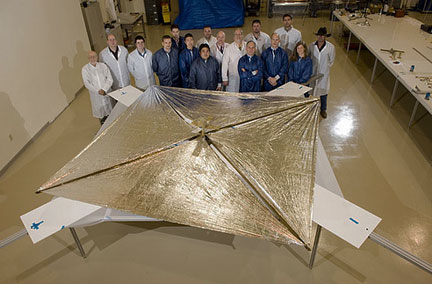
The Huntsville-based NanoSail-D team stands with the fully deployed sail at ManTech SRS technologies on April 16. 2008 after the successful deployment test. Credit: NASA/MSFC/D. Higginbotham
Actual deployment occurred on Jan. 20 at 10 p.m. EST and was confirmed today with beacon packets data received from NanoSail-D and additional ground-based satellite tracking assets. In addition, the NanoSail-D orbital parameter data set shows an appropriate change which is consistent with sail deployment. "This is tremendous news and the first time NASA has deployed a solar sail in low-Earth orbit," said Dean Alhorn, NanoSail-D principal investigator and aerospace engineer at the Marshall Center. "To get to this point is an incredible accomplishment for our small team and I can't thank the amateur ham operator community enough for their help in tracking NanoSail-D. Their assistance was invaluable. In particular, the Marshall Amateur Radio Club was the very first to hear the radio beacon. It was exciting!"
NanoSail-D will continue to send out beacon signals until the on-board batteries are expended and can be found at 437.270 MHz. It can be tracked on the NanoSail-D dashboard at: http://nanosaild.engr.scu.edu/dashboard.htm.
It is estimated that NanoSail-D will remain in low-Earth orbit between 70 and 120 days, depending on atmospheric conditions. NanoSail-D is designed to demonstrate deployment of a compact solar sail boom technology. This research demonstration could lead to further advances of this alternative solar sail propulsion and the critical need for new de-orbit technologies. This ejection experiment also demonstrates a spacecraft's ability, like the Fast, Affordable, Science and Technology Satellite, or FASTSAT, to eject a nanosatellite from a micro-satellite, while avoiding re-contact with the primary satellite.

